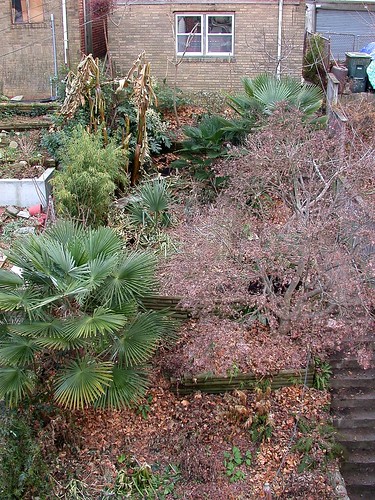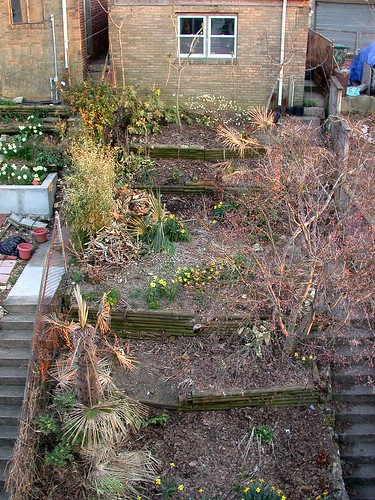

Garden, early December (left), mid-April (right) (click on photos to see larger version)
This side-by-side comparison shows very graphically how bad a hit my garden, and especially my palms, took after this winter. The photo on the left was taken in early December, after a hard freeze had knocked down the hardy banana (Musa basjoo) but before the series of cold waves we had in January. The photo on the right was taken just today; daffodils may be blooming merrily but not much else is looking good! Note the windmill palms: Trachycarpus fortunei "Bulgarian" in the lower left, T. fortunei "Nainital" at upper right, and T. wagnerianus immediately to its left.
The two palms in the upper part of the garden were very badly damaged, with their spears as well as several leaves pulling out. I've already cut all the fronds off the T. wagnerianus, and about half the fronds from the other two. This is what they look like now:

Trachycarpus wagnerianus after spear and leaves pulled
Even with this damage, there's a chance they will come back. For my waggie it's a pretty slim chance, as it suffered damage before the other two and all its foliage was killed (see Waggie vs. Nainital). I have a bit more hope for the "Nainital", which still has some green in about half of its leaves. But as I noted yesterday (Bulgarian wins!), my "Bulgarian" is already pushing out new growth, despite looking almost as bad as the "Nainital":

New growth on Trachycarpus fortunei "Bulgarian"
There's a lot of chatter among hardy palm growers, and on various discussion boards, as to the "hardiest" strains of windmill palms. These are generally grown from seeds of palms known to have survived temperatures at the low end of their cold tolerance--often cold events that killed the majority of palms around them--and are identified with quasi-cultivar names based on their origin like "Taylor", "Bulgarian", or "Nainital". Many growers now consider "Nainital" to be one of the superior hardy strains, whereas many are noting their "Bulgarians" did not fare as well. The reverse was true for me, although my "Nainital" was my clear winner in previous years. (Many growers still swear by "Taylor" but when I grew one of these several years ago, it suffered spear pull even after mild winters and I finally removed it after one winter when it suffered massive damage.)
Different growers seem to have very different experiences, vouching for one or another of these strains but with no particular consistency that I can see. Why does one palm live, and another one die? I have to wonder, when particular palms survive after a winter that kills so many others, is it really due to any kind of intrinsic/genetic cold tolerance, or is it just plain chance, or due to non-genetic influences that we still don't understand? There are a lot of extrinsic factors like soil composition and moisture, proximity to buildings, exposure to winter sun and wind, and who knows what else that can all make a big difference to their survival but are hard to control. I hope to harvest seeds from my "Bulgarian" (which bloomed for the first time last year, revealing itself as a female) but in the end, are we kidding ourselves that we can actually select for hardier strains by planting seeds from the survivors?

Female flowers on T. fortunei "Bulgarian" (May 2013)

I don't follow palm discussions as close as I used to and Bulgarian I have yet to across here but the rest I have seen and we have a couple of Naini Tal too. Enthusiasts have their individual opinions on which one is the hardiest, of a bunch that essentially look the same. With your experience the Bulgarian looks like a top contender for the hardiest crown.
ReplyDeleteYes, many different opinions based on many different experiences. Hence my skepticism.
DeleteI think planting seeds of plants that survive extreme events IS the best way to ensure future success. It brings me back to biology class - your palm survived extreme events, and lets for argument sake it's a genetic reason. Chances are some of the seeds will pass down the genetic variant that helped it survive the cold, while other seeds will not have that variant. Over time, if you were to sprout every seed, and keep collecting seeds from the survivors of cold winters you would end up with a strain that should reliably survive. It's no different then how dog breeders make different breeds, except the time from sprout to seed takes a lot longer with the palm than a dog, and the total number of potential offspring is much greater with the palm, so one could spend their entire life and many acres of land playing this out.
ReplyDeleteI hope you're right, I'm just not convinced. In principle you're correct and T. fortunei is a fairly variable species, which I think (hope) indicates there's a fair amount of genetic diversity among the cultivated populations (there are no known wild populations). Even if we can't select to make the species hardier, maybe we can weed out the weaker/less hardy individuals, and produce strains that are more RELIABLY hardy. Does that make sense?
DeleteWell, I think that after a few generations does make a species hardier, or at least a cultivar more hardy. It's saying the same thing using different words :).
DeleteIt was such a hard winter for those of us who like to push our zones. I am just now experimenting with a few palms in my Austin garden (Med fan palms and our native Sabal minor), and while those came through our 20-degree freezes just fine, some of my Mexican plants sure took a beating. I haven't had the heart to photograph them yet.
ReplyDeleteA hard winter for sure, but also an educational one that provided a good test for all those plants we're pushing, especially plants that are new to cultivation and whose limits aren't really known yet. So I definitely have mixed feelings; I'm sorry to lose certain favorite plants (like one or possibly two palms) but I'll come out of it knowing a whole lot more than I did before.
Delete